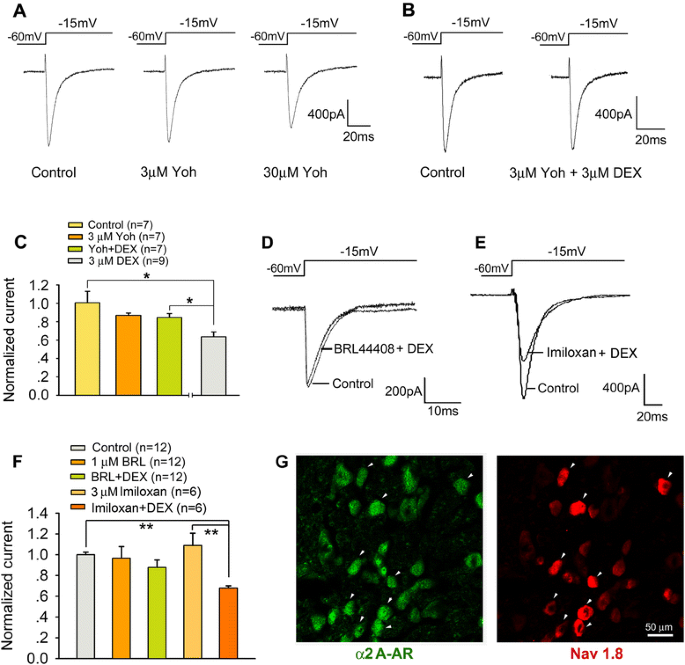The Chemokine CCL2 Increases Nav1.8 Sodium Channel Activity in Primary Sensory Neurons through a Gβγ-Dependent Mechanism
Por um escritor misterioso
Last updated 30 junho 2024

Changes in function of voltage-gated sodium channels in nociceptive primary sensory neurons participate in the development of peripheral hyperexcitability that occurs in neuropathic and inflammatory chronic pain conditions. Among them, the tetrodotoxin-resistant (TTX-R) sodium channel Nav1.8, primarily expressed by small- and medium-sized dorsal root ganglion (DRG) neurons, substantially contributes to the upstroke of action potential in these neurons. Compelling evidence also revealed that the chemokine CCL2 plays a critical role in chronic pain facilitation via its binding to CCR2 receptors. In this study, we therefore investigated the effects of CCL2 on the density and kinetic properties of TTX-R Nav1.8 currents in acutely small/medium dissociated lumbar DRG neurons from naive adult rats. Whole-cell patch-clamp recordings demonstrated that CCL2 concentration-dependently increased TTX-resistant Nav1.8 current densities in both small- and medium-diameter sensory neurons. Incubation with CCL2 also shifted the activation and steady-state inactivation curves of Nav1.8 in a hyperpolarizing direction in small sensory neurons. No change in the activation and inactivation kinetics was, however, observed in medium-sized nociceptive neurons. Our electrophysiological recordings also demonstrated that the selective CCR2 antagonist INCB3344 [ N -[2-[[(3 S ,4 S )-1- E 4-(1,3-benzodioxol-5-yl)-4-hydroxycyclohexyl]-4-ethoxy-3-pyrrolidinyl]amino]-2-oxoethyl]-3-(trifluoromethyl)benzamide] blocks the potentiation of Nav1.8 currents by CCL2 in a concentration-dependent manner. Furthermore, the enhancement in Nav1.8 currents was prevented by pretreatment with pertussis toxin (PTX) or gallein (a Gβγ inhibitor), indicating the involvement of Gβγ released from PTX-sensitive Gi/o-proteins in the cross talk between CCR2 and Nav1.8. Together, our data clearly demonstrate that CCL2 may excite primary sensory neurons by acting on the biophysical properties of Nav1.8 currents via a CCR2/Gβγ-dependent mechanism.

PDF) Functional up-regulation of Nav1.8 sodium channel in Aβ afferent fibers subjected to chronic peripheral inflammation

Dexmedetomidine inhibits Tetrodotoxin-resistant Nav1.8 sodium channel activity through Gi/o-dependent pathway in rat dorsal root ganglion neurons, Molecular Brain

TRPV 1 receptor inhibition decreases CCL 2-induced hyperalgesia

CC chemokine ligand 2 upregulates the current density and expression of TRPV1 channels and Nav1.8 sodium channels in dorsal root ganglion neurons. - Abstract - Europe PMC

Increased Resurgent Sodium Currents in Nav1.8 Contribute to Nociceptive Sensory Neuron Hyperexcitability Associated with Peripheral Neuropathies

Chemokine CCL7 mediates trigeminal neuropathic pain via CCR2/CCR3-ERK pathway in the trigeminal ganglion of mice - Lin-Peng Zhu, Meng-Lin Xu, Bao-Tong Yuan, Ling-Jie Ma, Yong-Jing Gao, 2023

PDF) The Chemokine CCL2 Increases Nav1.8 Sodium Channel Activity in Primary Sensory Neurons through a G -Dependent Mechanism

The Chemokine CCL2 Increases Nav1.8 Sodium Channel Activity in Primary Sensory Neurons through a Gβγ-Dependent Mechanism

Dexmedetomidine inhibits Tetrodotoxin-resistant Nav1.8 sodium channel activity through Gi/o-dependent pathway in rat dorsal root ganglion neurons, Molecular Brain

Chemokine CCL7 mediates trigeminal neuropathic pain via CCR2/CCR3-ERK pathway in the trigeminal ganglion of mice - Lin-Peng Zhu, Meng-Lin Xu, Bao-Tong Yuan, Ling-Jie Ma, Yong-Jing Gao, 2023

Neonatal Injury Modulates Incisional Pain Sensitivity in Adulthood: An Animal Study - ScienceDirect
Recomendado para você
-
Lavoisier - O Lavoisier traz mais uma facilidade para30 junho 2024
-
Lavoisier - Acesse todos os seus resultados de exames30 junho 2024
-
 Lavoisier Laboratório de exames e de Imagem30 junho 2024
Lavoisier Laboratório de exames e de Imagem30 junho 2024 -
 Image Memorial Diagnóstico por Imagem30 junho 2024
Image Memorial Diagnóstico por Imagem30 junho 2024 -
 Lavoisier Laboratório e Imagem30 junho 2024
Lavoisier Laboratório e Imagem30 junho 2024 -
 Antoine Lavoisier Cartoons and Comics - funny pictures from CartoonStock30 junho 2024
Antoine Lavoisier Cartoons and Comics - funny pictures from CartoonStock30 junho 2024 -
 Lavoisier Cartoons and Comics - funny pictures from CartoonStock30 junho 2024
Lavoisier Cartoons and Comics - funny pictures from CartoonStock30 junho 2024 -
 Why some Latino communities fear the COVID-19 vaccine, and what can be done to help, Rice News, News and Media Relations30 junho 2024
Why some Latino communities fear the COVID-19 vaccine, and what can be done to help, Rice News, News and Media Relations30 junho 2024 -
 Quadro Decorativo Torre Eiffel Preto e Branco30 junho 2024
Quadro Decorativo Torre Eiffel Preto e Branco30 junho 2024 -
Patricia Oliveira on LinkedIn: 🩷💓🩷💓💕30 junho 2024
você pode gostar
-
 new pfp lolz by heyitstoni on Newgrounds30 junho 2024
new pfp lolz by heyitstoni on Newgrounds30 junho 2024 -
 Underground Rap: 5 Artists Audiophiles will love in 2023, by Lily Morgan30 junho 2024
Underground Rap: 5 Artists Audiophiles will love in 2023, by Lily Morgan30 junho 2024 -
 Noclip VR Review - VR30 junho 2024
Noclip VR Review - VR30 junho 2024 -
 Episode #111: Will your New Look Blind You?30 junho 2024
Episode #111: Will your New Look Blind You?30 junho 2024 -
Feito - Capas de Álbuns Brasileiros com Temas de Anime30 junho 2024
-
 First Look Images of Tom Holland's Nathan Drake In UNCHARTED30 junho 2024
First Look Images of Tom Holland's Nathan Drake In UNCHARTED30 junho 2024 -
 25cm fnaf plush toy plush Golden Freddy Fazbear Mangle bonnie foxy Stuffed Doll Toys Sister Location30 junho 2024
25cm fnaf plush toy plush Golden Freddy Fazbear Mangle bonnie foxy Stuffed Doll Toys Sister Location30 junho 2024 -
 Listen to Os Melhores do Mundo Trap ⚽⚽ (Blue Lock), The Best30 junho 2024
Listen to Os Melhores do Mundo Trap ⚽⚽ (Blue Lock), The Best30 junho 2024 -
 Resgatar Codigos de Diamantes Gratis 2023 - Recompensas FF30 junho 2024
Resgatar Codigos de Diamantes Gratis 2023 - Recompensas FF30 junho 2024 -
 One Piece: 5 Most Powerful Mythical Zoan Devil Fruits That30 junho 2024
One Piece: 5 Most Powerful Mythical Zoan Devil Fruits That30 junho 2024



